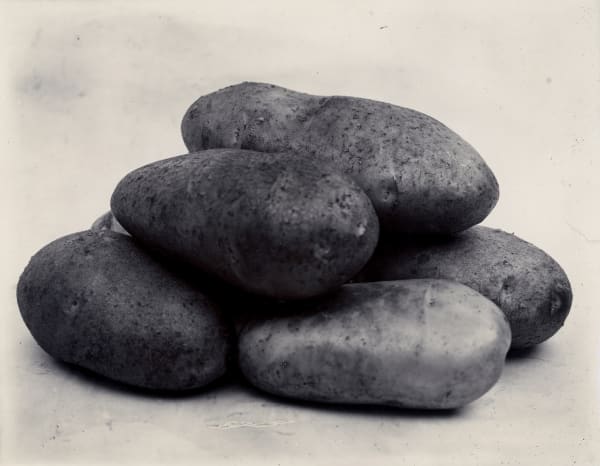-
The remarkable story of the discovery of Charles Jones’s long-forgotten photographs – found in a leather trunk in the early morning at Bermondsey Market in 1981, is the stuff of art collecting legend. It is every collector’s dream to rediscover a forgotten masterpiece and Sean Sexton was particularly fortunate that a fellow collector-dealer had seen the contents of the trunk earlier that morning and decided to pass.
Sean was able to purchase the trunk and its contents of around 500 photographs for a nominal sum, and so the rediscovery of Charles Jones, plantsman, gardener and photographer, began.
-

-
His work there was reported in the The Gardeners’ Chronicle on September 20th, 1905 : “The present gardener, Charles Jones, has had a large share in the modelling of the gardens as they now appear, for on all sides can be seen evidences of his work in the making of flowerbeds and borders and the planting of fruit trees etc… Pleasing as are these decorative portions of the garden, the fruit and vegetables quarters are equally so and this especially applies to the fruit gardens.”
-
It is believed that Jones took most of his photographs whilst working at Ote Hall as some of his photographs of the borders referred to in the Gardeners' Chronicle survive. He left Ote Hill around the time of the article and the rest of his life remains something of a mystery.
Jones died in Lincolnshire in 1959 at the age of 92 and would have almost certainly passed into obscurity were it not for Sean Sexton’s discovery. The leather trunk contained a group of gold toned silver gelatin prints, mostly of vegetables, fruits and flowers, each one carefully inscribed with its variety in pencil on the reverse and initialled CJ.
-

-
The lack of shadows are equally distinctive and it seems likely that the photographs were taken on bright sunless days. The transformation of an earthy root vegetable into an abstracted orb is magical and perhaps could only have been undertaken by someone who appreciated and understood the creation of the specimen as much as that of the photographs, which were developed from glass-plate negatives through the use of sunlight to allow the gold-toned images to appear out of the paper.
-

-
A large group of Charles Jones’s photographs are to be at the centre of a major exhibition at Dulwich Picture Gallery that was planned to open very shortly but has, sadly, been postponed until the later part of this year. Unearthed: Photography’s Roots will be the first major photography exhibition to be held at the gallery, which holds a significant group of still life paintings. The exhibition will follow the thread of still life as a subject in photography from its earliest days and Charles Jones’s prints will have a gallery of their own. We have timed this Viewing Room to coincide with the intended opening of the exhibition.
-
AVAILABLE WORKS
-
 Charles Jones, Peas, c. 1900View more details
Charles Jones, Peas, c. 1900View more details -
 Charles Jones, Vegetable Marrow, c.1900View more details
Charles Jones, Vegetable Marrow, c.1900View more details -
 Charles Jones, Tomato, Ailsa CraigView more details
Charles Jones, Tomato, Ailsa CraigView more details -

-
 Charles Jones, Onion Ailsa Craig, c.1900View more details
Charles Jones, Onion Ailsa Craig, c.1900View more details -
 Charles Jones, Beet, Globe, c.1900View more details
Charles Jones, Beet, Globe, c.1900View more details -

-

-

-

-
 Charles Jones, Marrow Long White c.1900, c.1900View more details
Charles Jones, Marrow Long White c.1900, c.1900View more details -
 Charles Jones, Beans in a Basket, c.1900View more details
Charles Jones, Beans in a Basket, c.1900View more details -

-
 Charles Jones, Madame Lombard, c.1900View more details
Charles Jones, Madame Lombard, c.1900View more details -

-
 Charles Jones, Decorative Dahlia California, c.1900View more details
Charles Jones, Decorative Dahlia California, c.1900View more details -
 Charles Jones, May Flowering Tulips Mixed c.1900View more details
Charles Jones, May Flowering Tulips Mixed c.1900View more details -
 Charles Jones, Iris Florentina, c.1900View more details
Charles Jones, Iris Florentina, c.1900View more details
-























